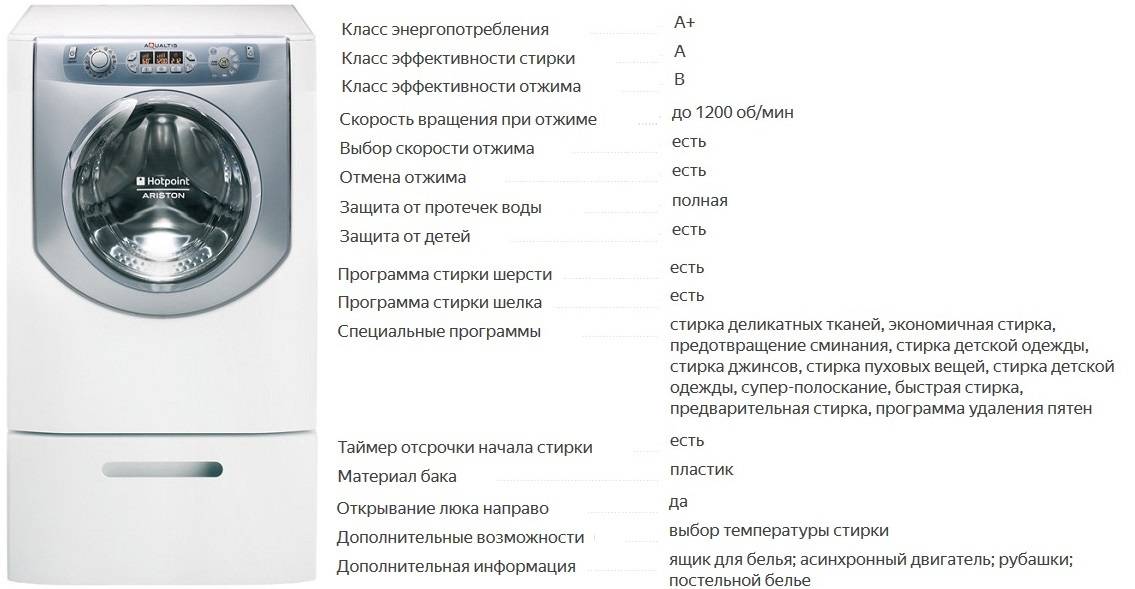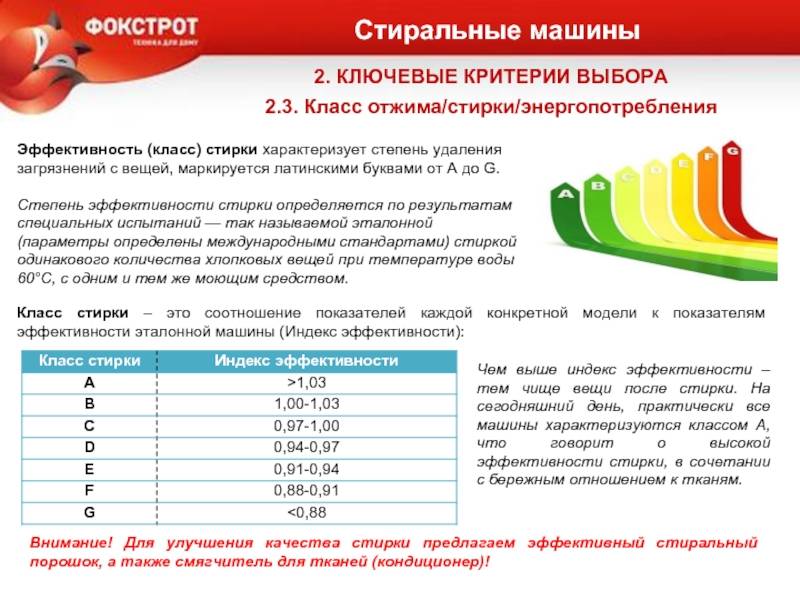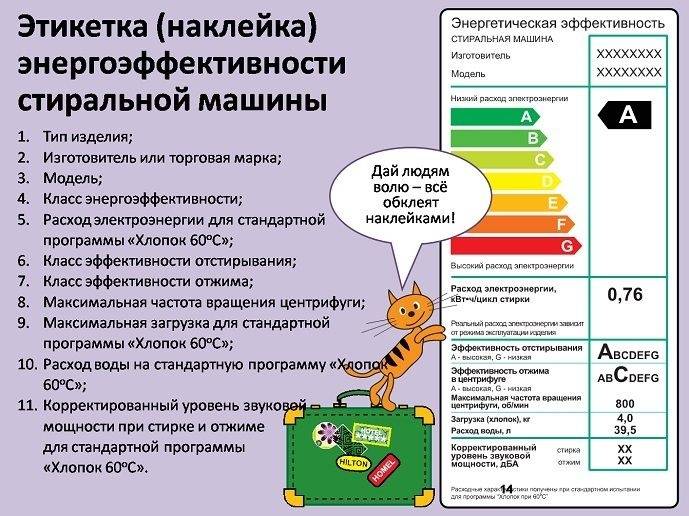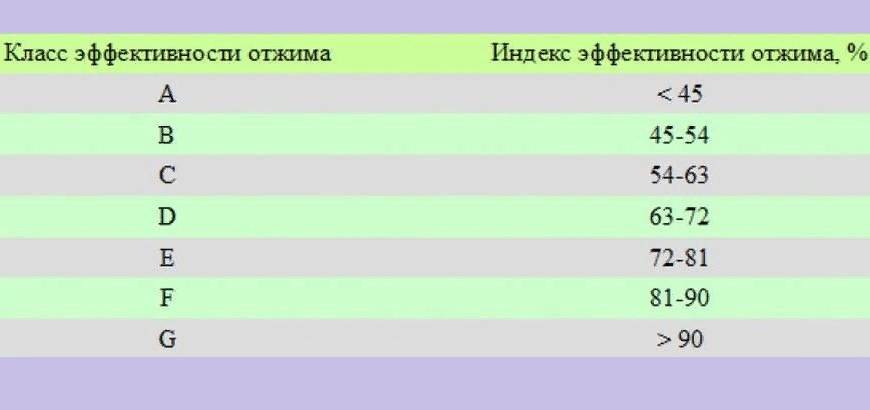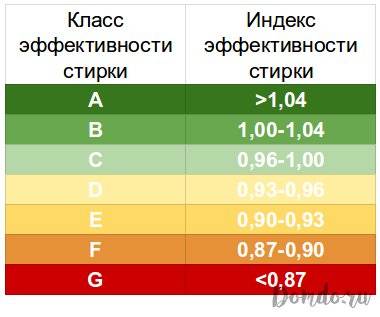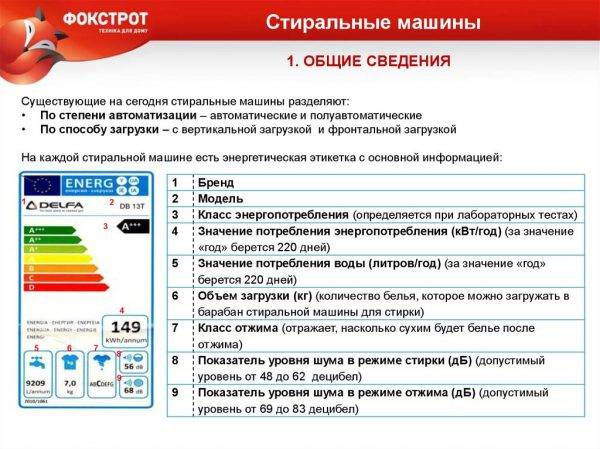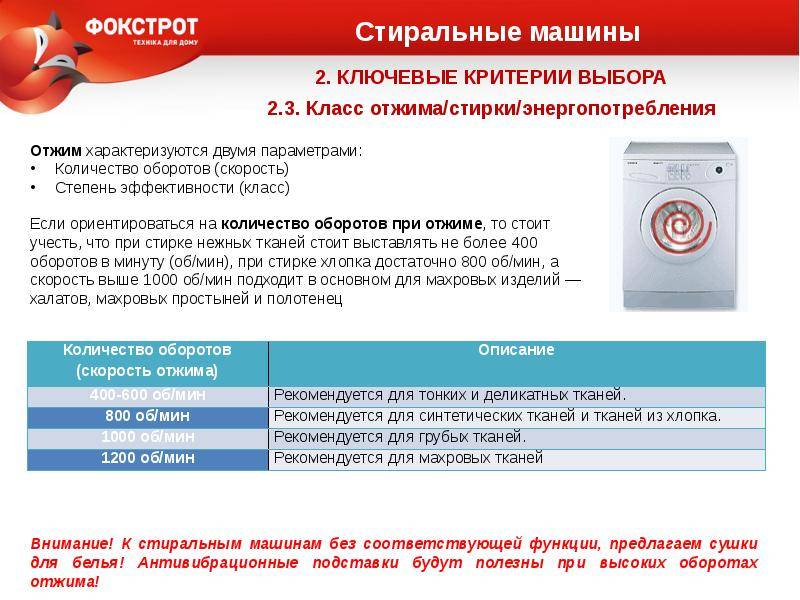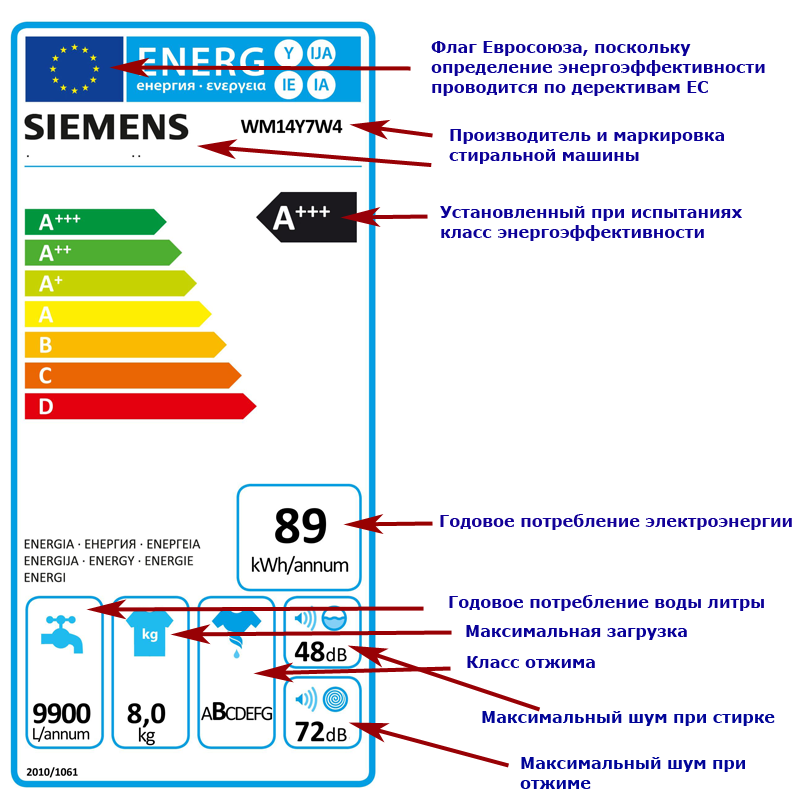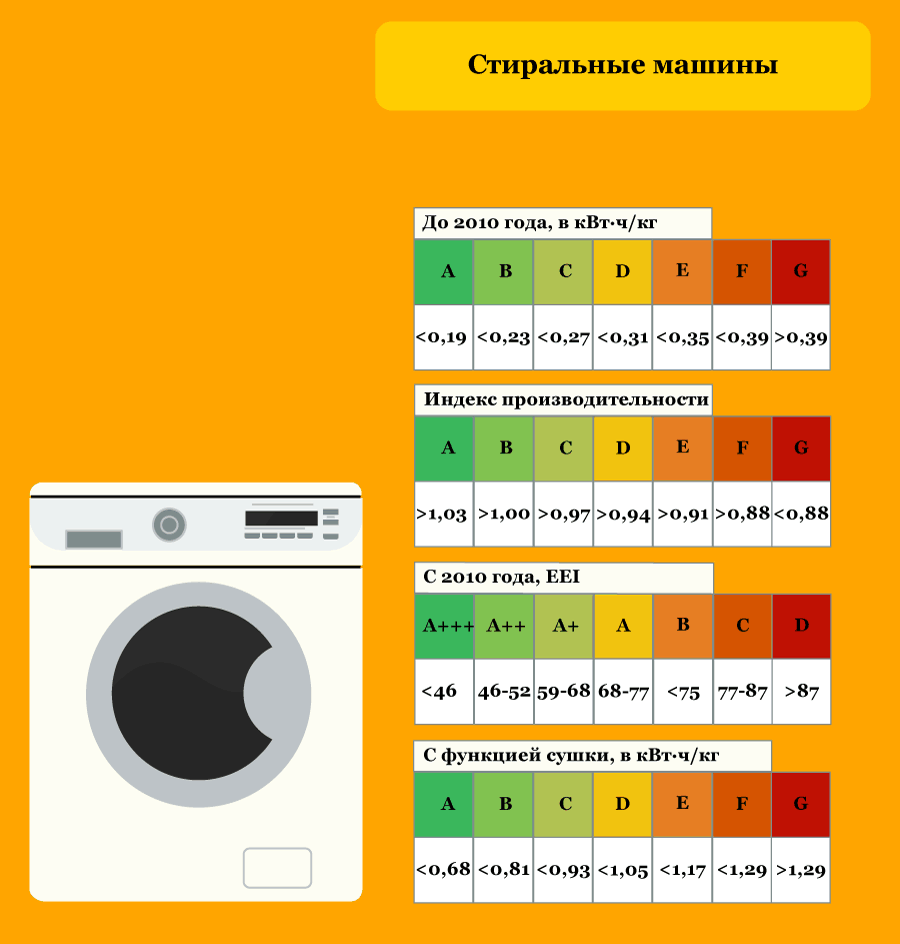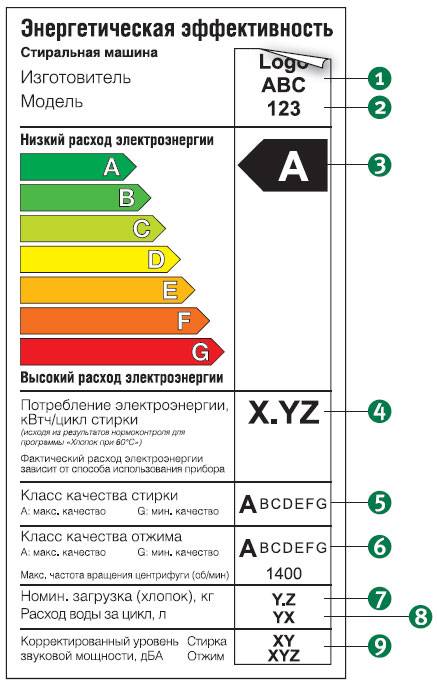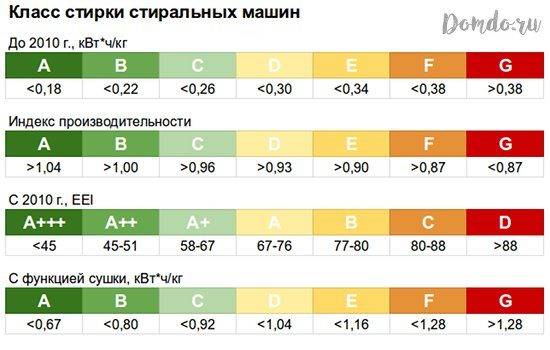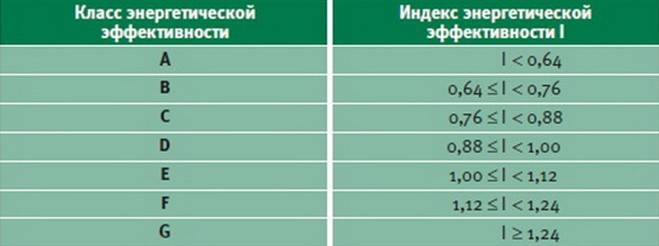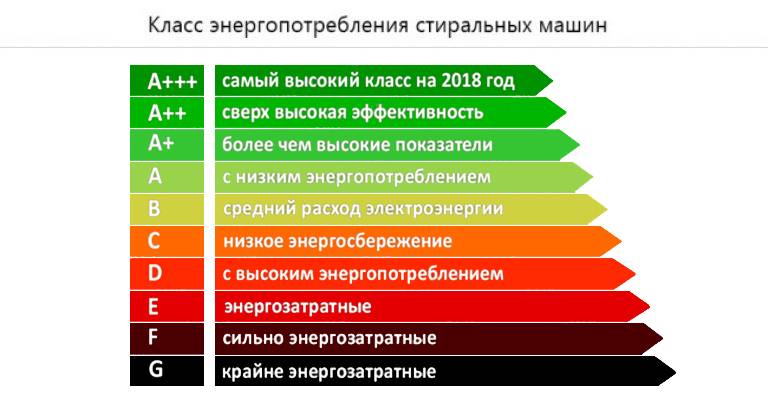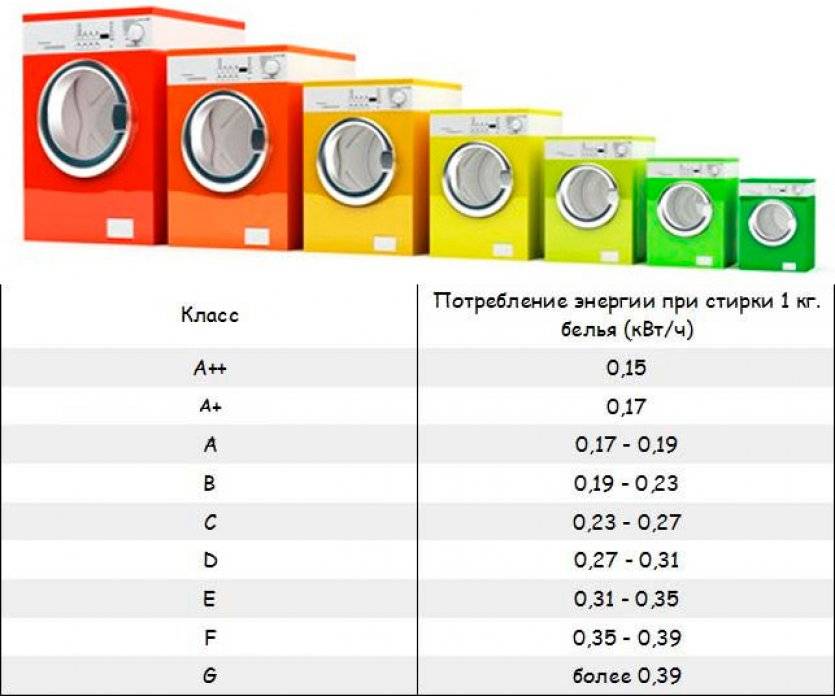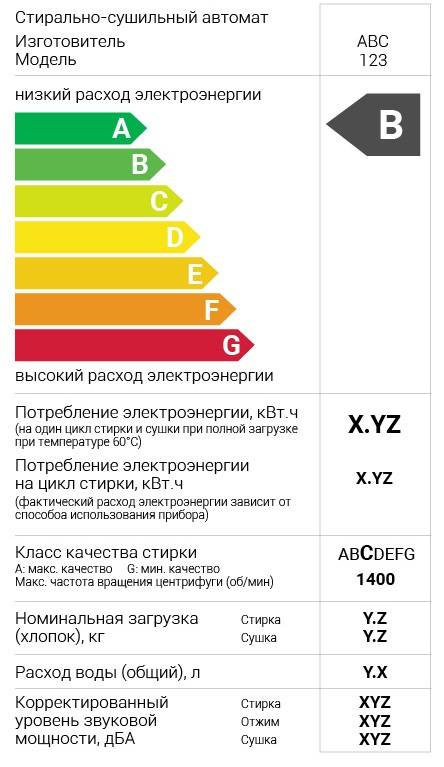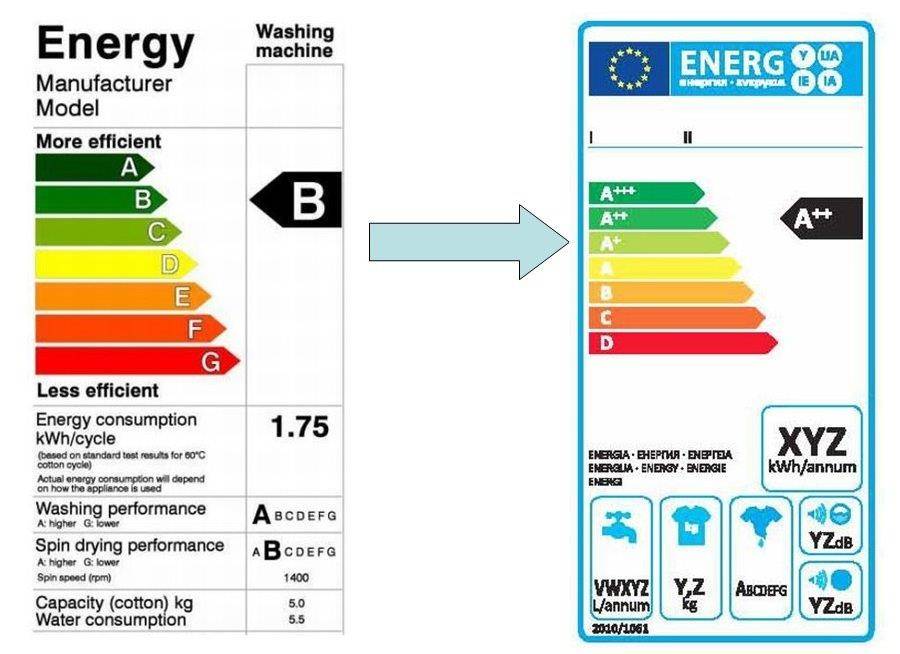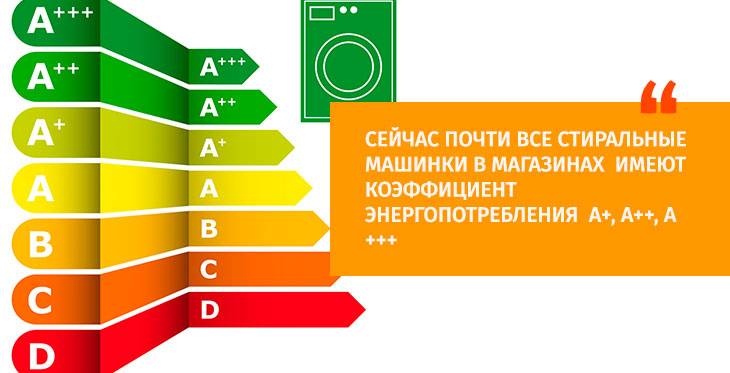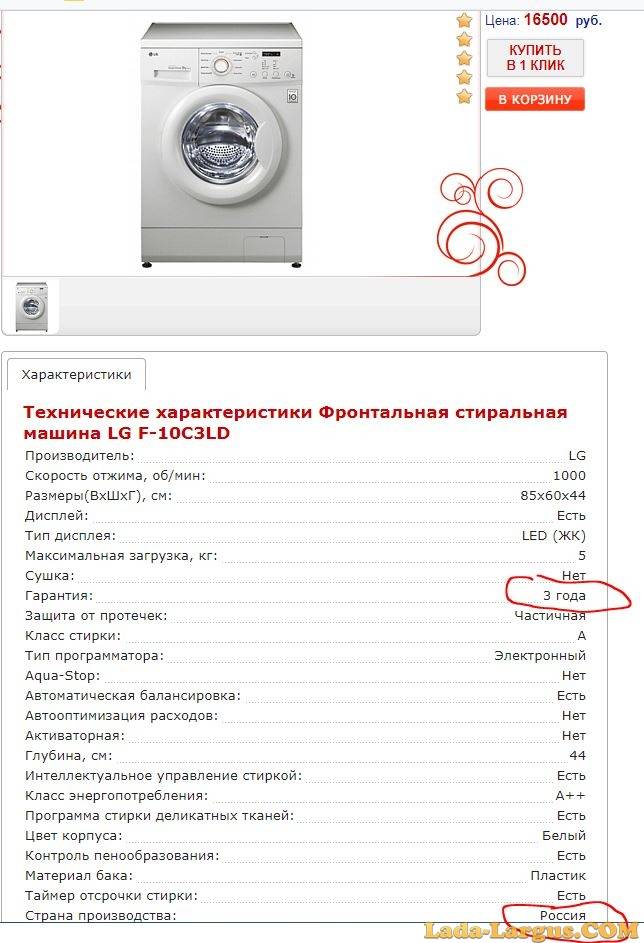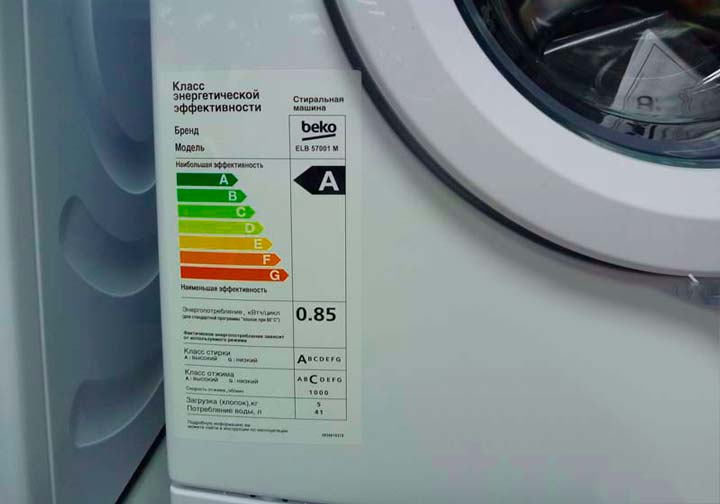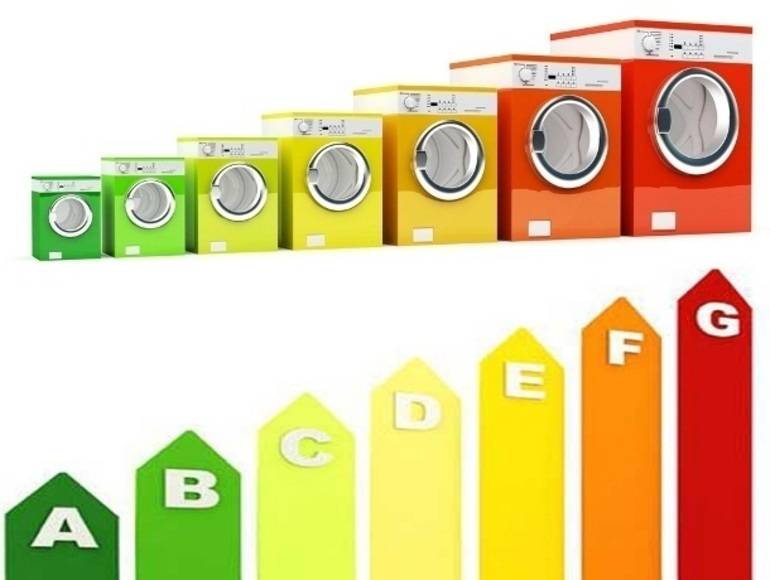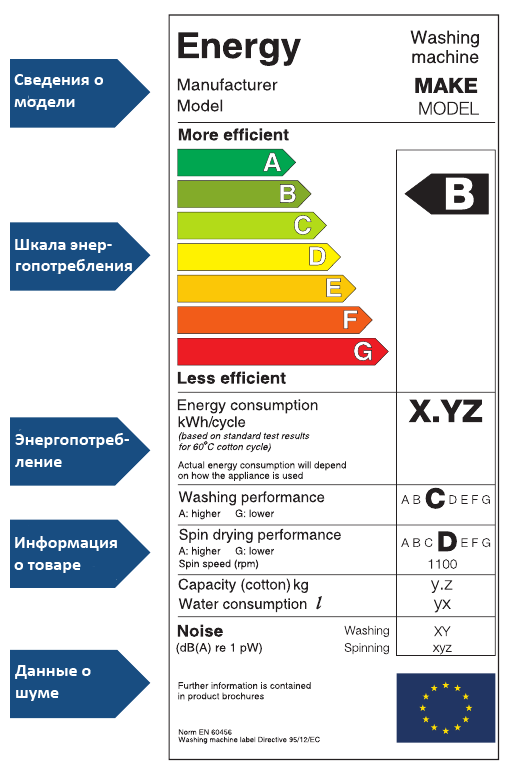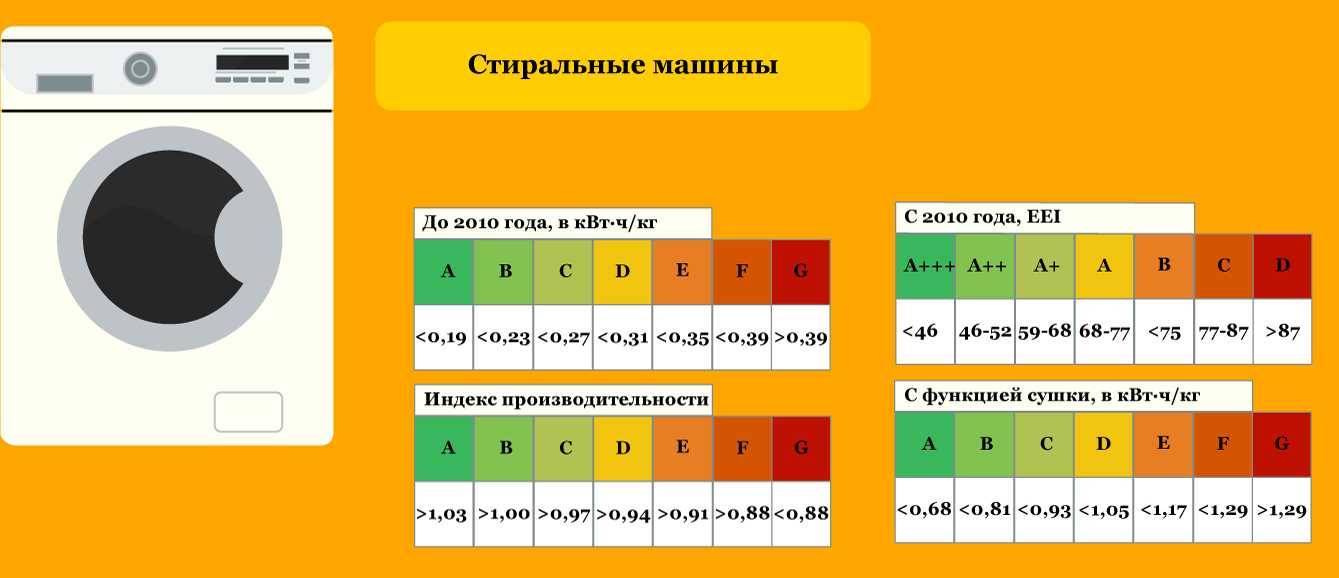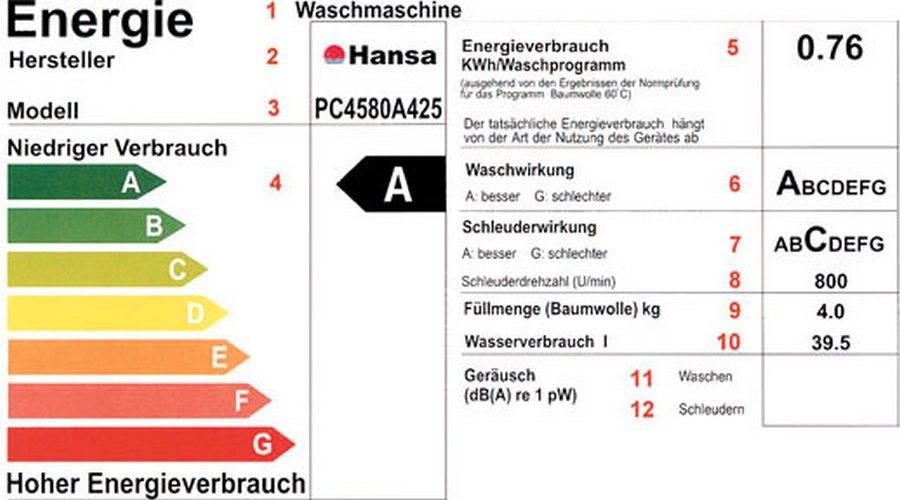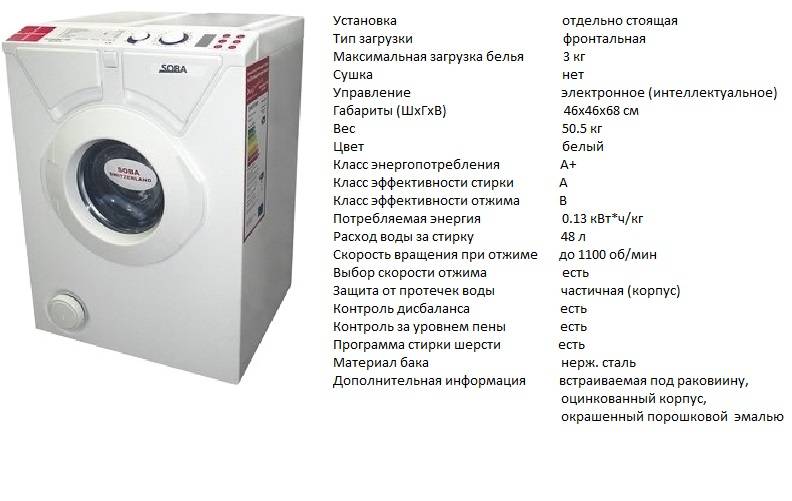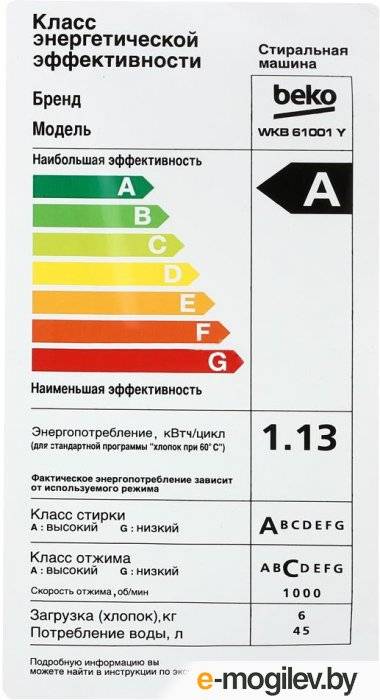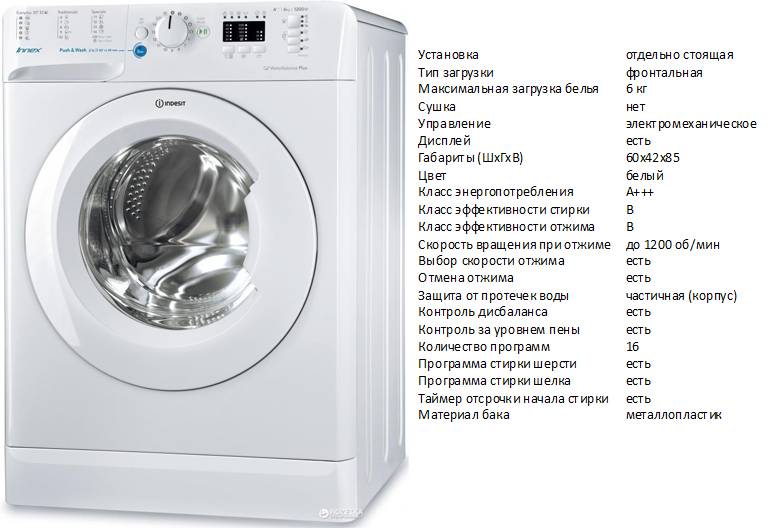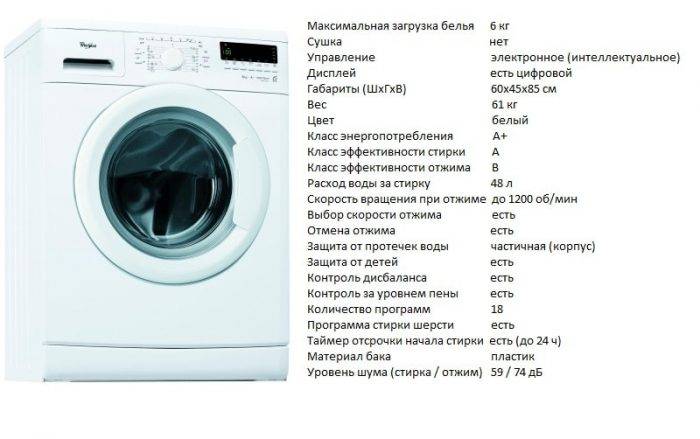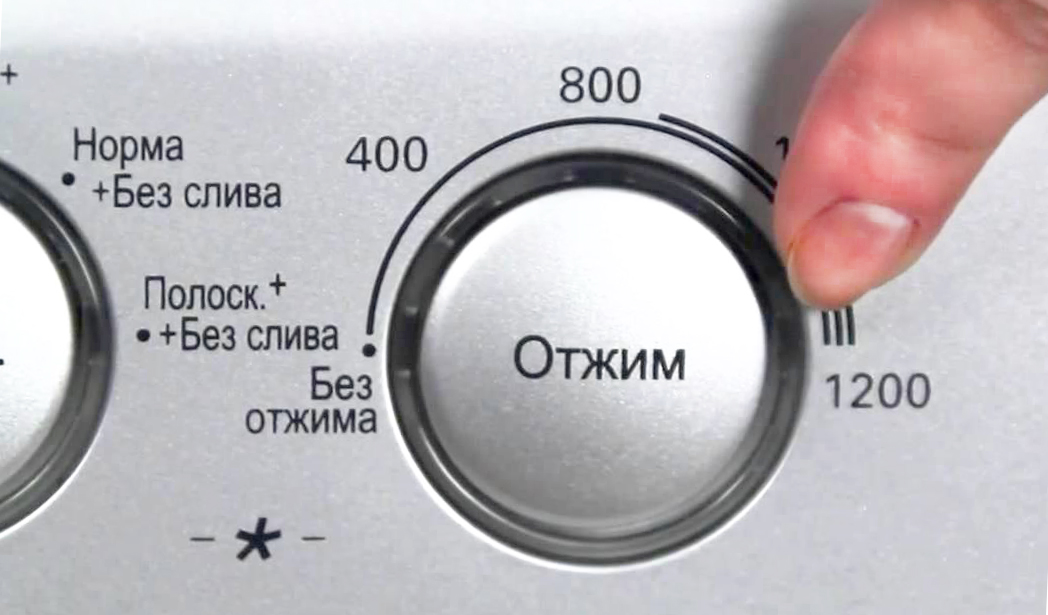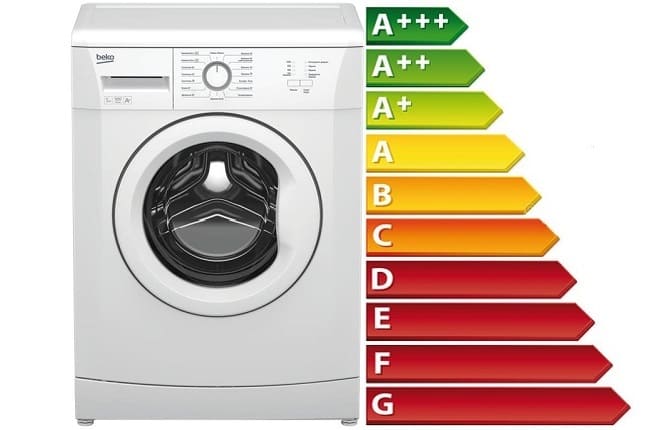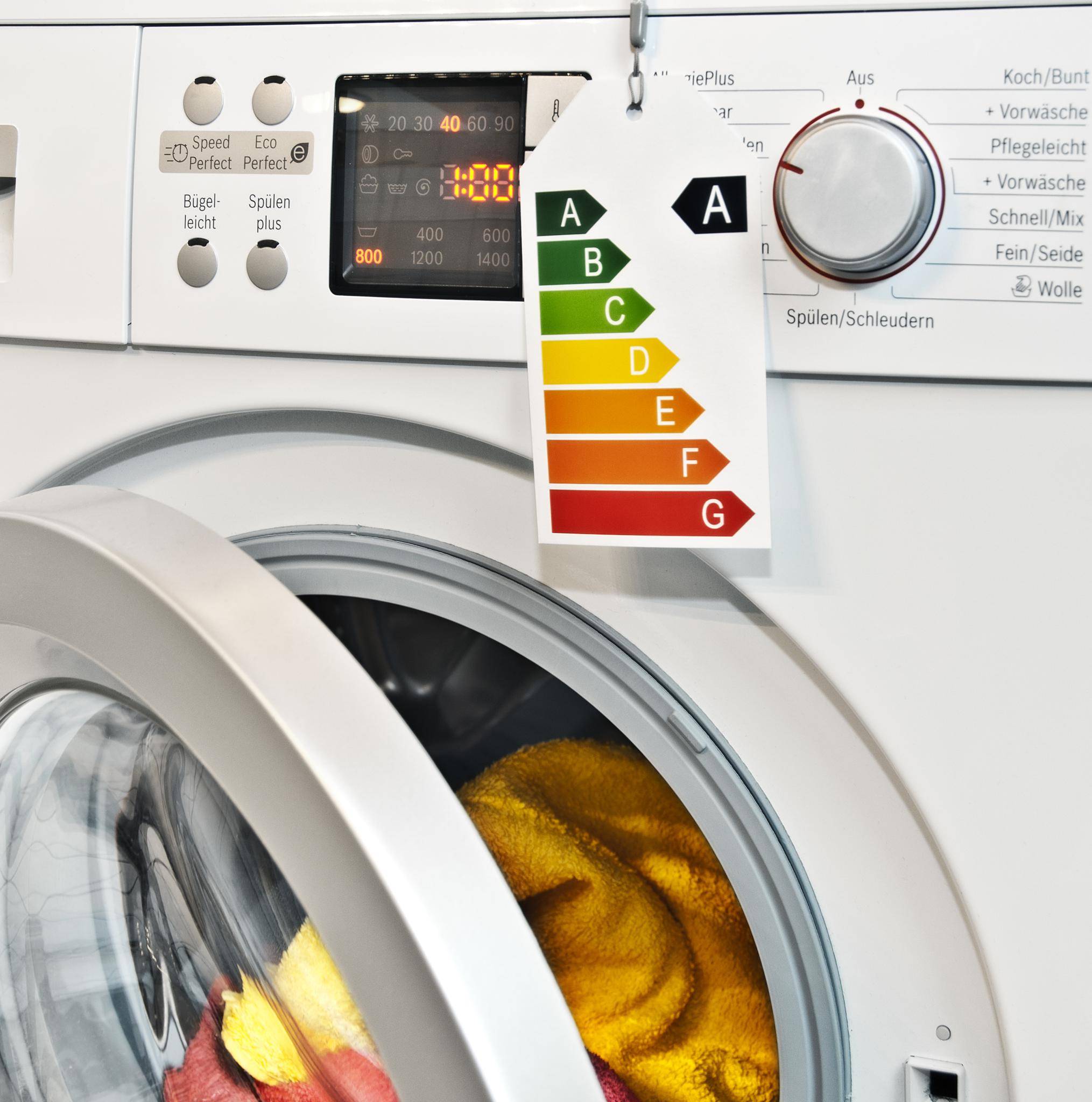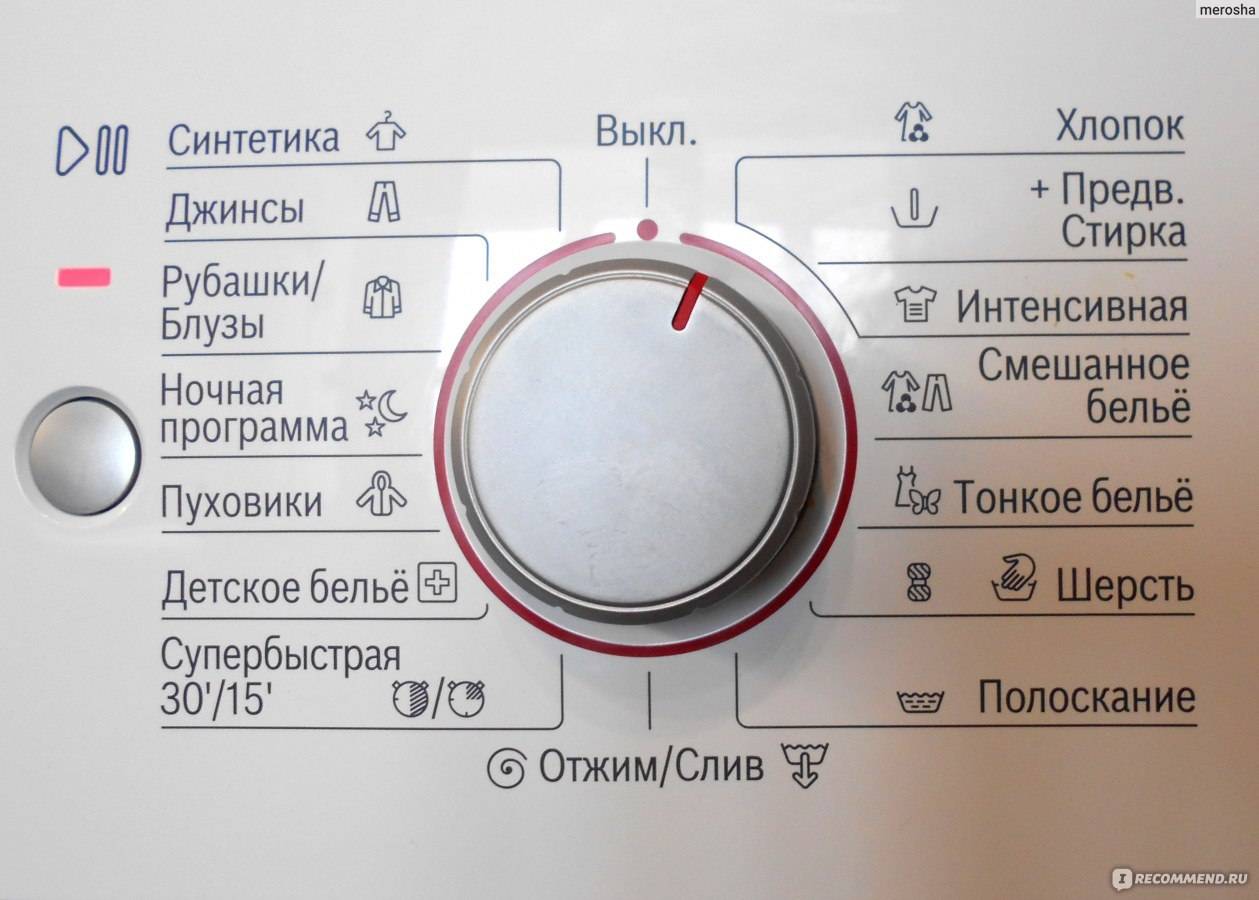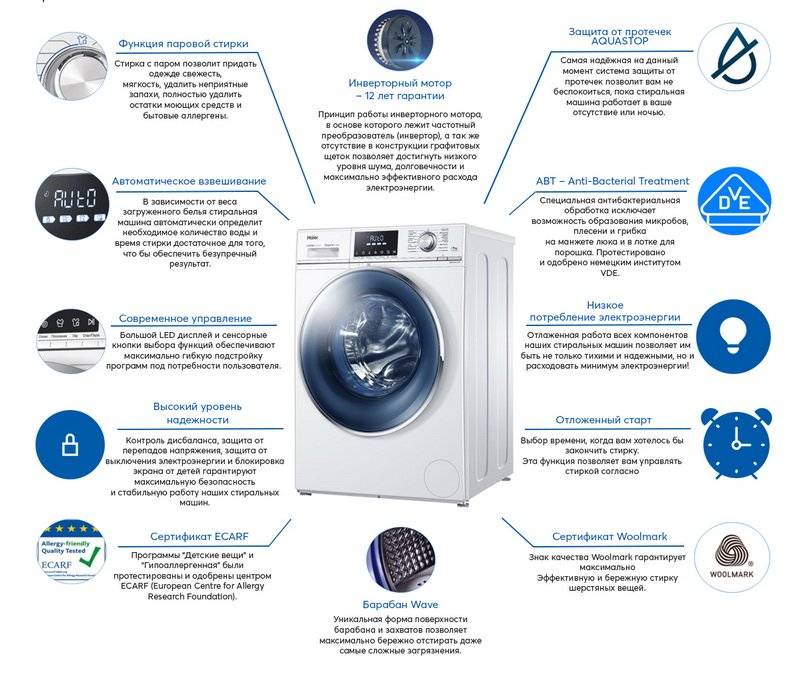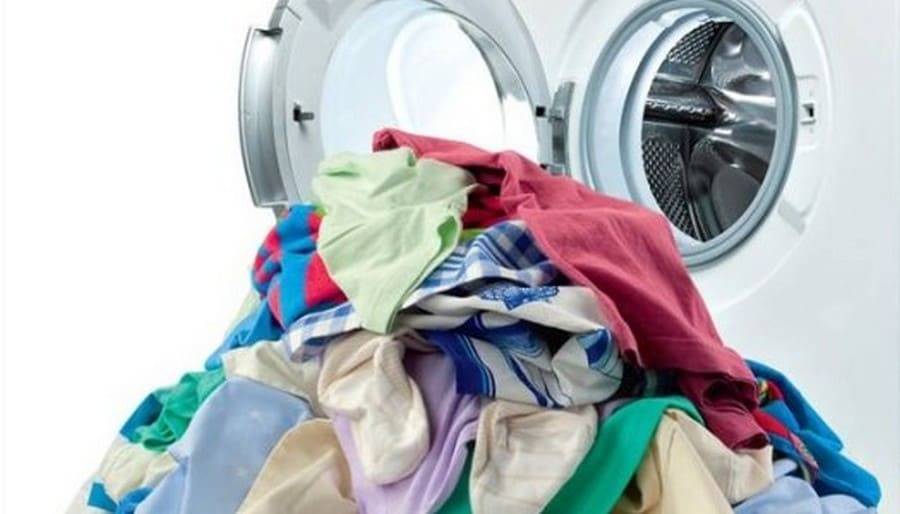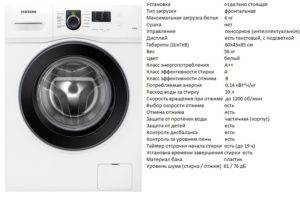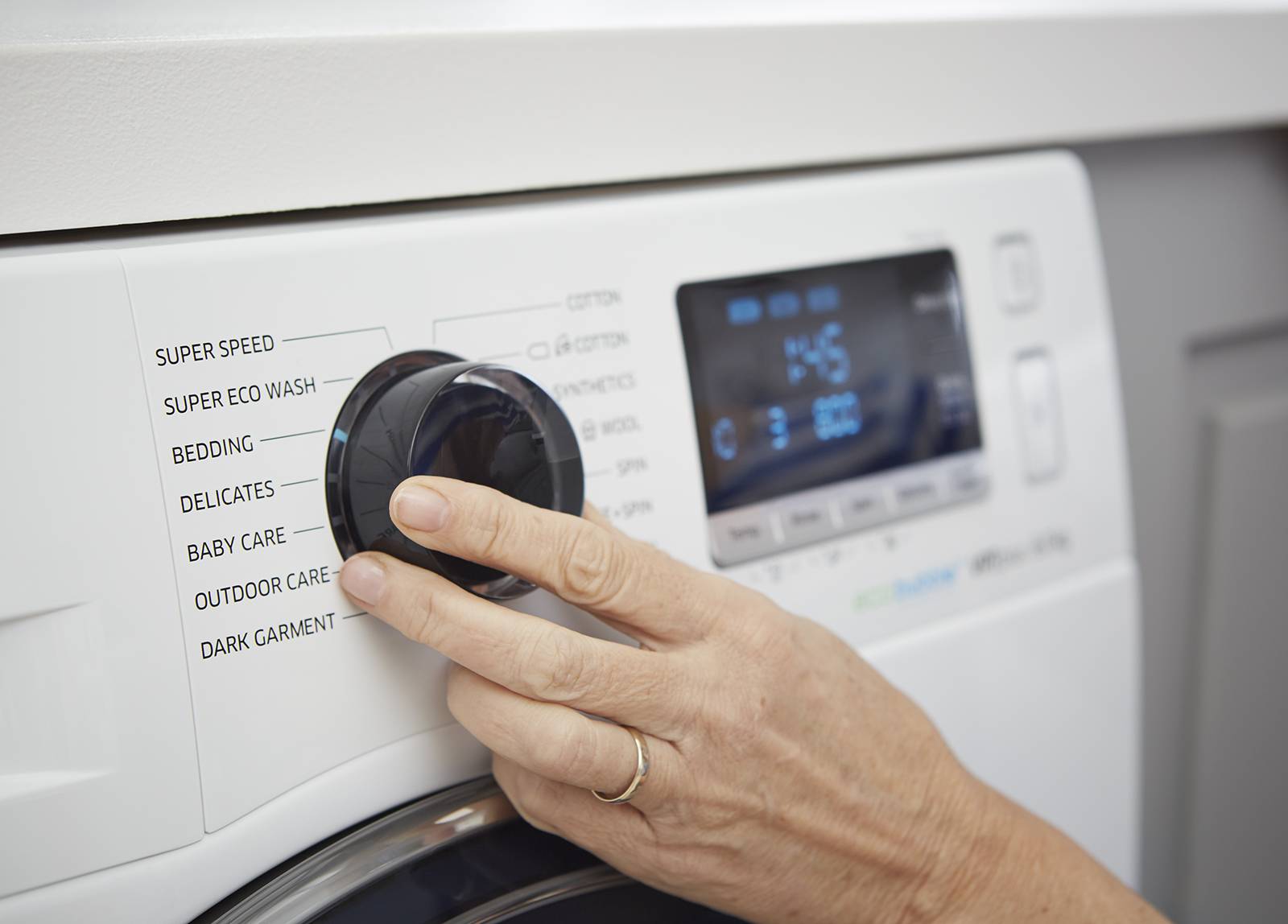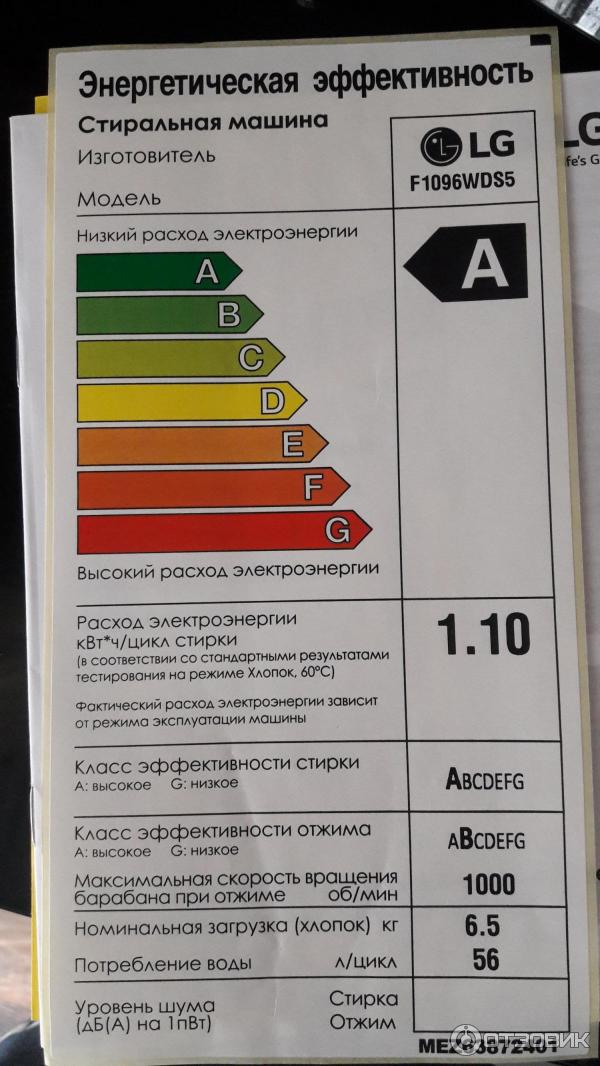Selection rules
Things to remember before going to the store:
As mentioned above, the efficiency of washing laundry depends on the class of the washing machine.
In principle, there is not such a big difference between A and B (except that B is cheaper, but they are practically equal in efficiency), but with regard to the class below C, then you should carefully think about the importance of just such an acquisition. You will save on the purchase once, but later on you will pay more for the consumed energy and, as a result, the initial savings will come to naught.
If you get lost in the store, and do not know which model is better and how they differ from each other, look for information on the case
It is there that manufacturers usually indicate all the necessary information - the amount of linen, classes, and so on.
Every year a number of new models appear, here the manufacturers spoil us on the one hand, and on the other - they confuse us, because the larger the model range, the more difficult the choice. The more modern the machine is, the more economical it is.
Determine for yourself in advance what to look for, and then your purchase will be successful.
What will the European indices tell you about?
First of all, you need to figure out what is spin class in washing machines. It is considered to be one of the most important parameters for evaluating modern models. It characterizes the percentage of moisture remaining in the washed items. This indicator depends on the number of drum revolutions per second - the higher the speed, the drier the things.
To calculate the effectiveness of this process at home, you need to weigh the wrung out laundry, dry it and weigh it again. Then a simple calculation should be made: subtract the weight of the dried laundry from the weight of the wet one, divide the result by the weight of dry clothes and multiply by 100%.
For example, after washing you weighed the laundry, 5 kg came out. After drying, its weight was reduced to 3 kg. As a result of subtraction, we get the number 2. Divide it by 3 - it turns out 0.66. We multiply the fraction by 100% - it turns out that the percentage of moisture is 66%.
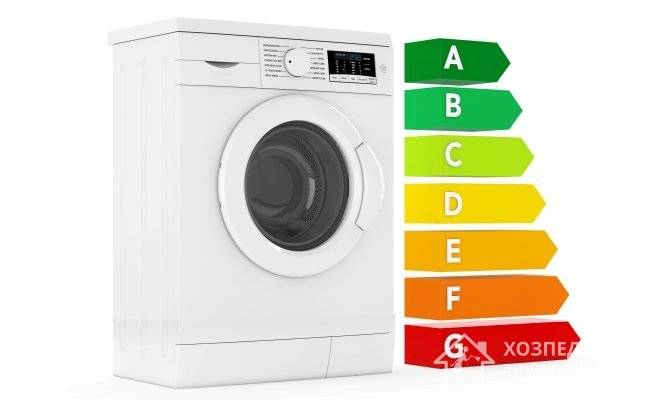 Spin efficiency classes
Spin efficiency classes
Fortunately, when buying equipment in a store, you don't have to count anything on your own. The spin class of the washing machine is usually indicated in the documentation for the model. It is classified with indices from A to G. This is the European standard for drying laundry, which is accepted all over the world. Each indicator indicates how dry your items will be after the end of the wash. Let's consider the classification in more detail:
- G - the percentage of moisture after spinning is above 90%. In such units, the laundry at the outlet will be only 10% dry. The number of drum revolutions per minute - 400;
- F - assumes a spin efficiency of 81-90% at a speed of 600 rpm;
- E - the percentage of moisture remaining after washing - 72-81%. The technique of this class will "spin" the laundry at 800 rpm;
- D - 63-72% moisture will remain in things. Speed - 1000 rpm;
- C - will provide a spin efficiency of 54-63%. In this case, the drum will spin at a speed of 1200 rpm;
- B - the washing machine spins the laundry at a speed of 1400 rpm, leaving no more than 45-54% moisture in it;
- A - provides the driest spinning - no more than 45% moisture remains in clothes. The speed is 1600 rpm.
Optimal speed settings for different materials
Not all materials can be washed as standard. For certain types of fabrics, a mode such as a delicate wash will be required. As a rule, on modern models of washing machines, you can set the required number of revolutions. Rotating the motor too fast can damage some tissues.
Linen, jeans, cotton, calico
For denim and cotton fabrics, the allowable value is 800 rpm.It is also recommended to activate the delicate wash cycle. Linen is an extremely delicate material, so the spin is either turned off or activated at the minimum number of revolutions.
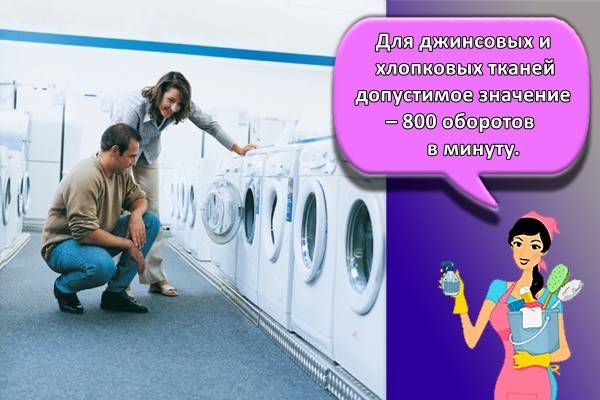
Satin, silk
Satin, silk and tulle items must be washed at 600 rpm, as these are rather thin and delicate materials. If there is such an opportunity, then the spin is turned off.
Wool
It is not recommended to wring out things made of wool. If there is no such option, it is recommended to set the minimum spin value (no more than 400 rpm).
Which brand should you choose?
Having decided on the functionality that you really need, proceed to the solution of an equally difficult task - the choice of the brand of the device. How to choose the right washing machine from the point of view of the manufacturer? Even experts do not undertake to unequivocally answer the question of which brand makes the best washing machines. Any brand of equipment has both pros and cons.
Such popular brands of washing machines as LG, Beko, Indesit, Samsung, Hotpoint Ariston, Candy, Whirpool, Gorenje, Zanussi, Atlant are famous for their rather good quality and decent functionality. These manufacturers often lead the sales ratings, because they produce a wide range of equipment designed for every taste and wallet. The cost varies depending on the set of functions, so the buyer can choose a model for himself both in the budget and in the middle or high price segment.
 Some manufacturers lure customers by offering good service support
Some manufacturers lure customers by offering good service support
The brands Siemens, Bosch, Electrolux, AEG, Hitachi are considered the most demanded in terms of price and quality ratio. The cost of such washing machines may differ markedly from the units of the previous category, but this is justified by maximum reliability. Manufacturers focus on high build quality and materials, and also offer a large selection of models, including budget lines of washing machines.
 Bosch washing machines have won the trust of consumers for a long time
Bosch washing machines have won the trust of consumers for a long time
It would not be superfluous to mention the manufacturers of luxury equipment - Miele, Smeg, Asko, Schulthess. The products of these brands are expensive, but they are of high quality and can serve for more than 15-20 years. It is usually bought for professional use, such as in laundries. Also, the buyer has to pay extra for the exclusive design of devices that some brands offer.
Standard spin classification
Class assignment has a specific purpose. It is necessary to identify the levels of performance of technology. Tests must be carried out to determine the quality of the wash. As you know, stains on clothes have a different reason for their appearance, and the fabrics also differ from each other.
For the duration of the tests, the quality of the wash in the test washer is compared with that in the standard washer. The process is as follows: specific materials with specific contaminants are taken and loaded into washing machines. The devices wash the material for about one hour at a temperature of 60 degrees, using the same powder.
At the end of the work, the fabrics are compared with each other with a special device. This device is intended for a more independent assessment, and excludes subjective factors. Based on the results, the washing class is determined. The parameter of diagnosis is the efficiency value corresponding to its class.
Class B - very good washing
Grade C - good wash
Class D - normal wash
Class F - poor wash
Class G - very bad wash
As in the definition of the previous parameter, in this case, research is also carried out. The spin quality is determined by weighing the laundry in dry and wet form. The difference between these results is what justifies the spin class. Thus, letter designations also start with A and end with G. Where "A" is the highest.
The spin quality is determined by such points as:
- Drum size
- The number of revolutions of the device
- Duty cycle time range
- Type of laundry when spinning
The moisture index of the laundry after the spin process is as follows:
- "A" - {amp} lt; 45%.
- "B" - 45-54%.
- "C" - 54-63%.
- "D" -63-72%.
- "E" - 72-81%.
- "F" - 81-90%.
- "G" - {amp} gt; 90%.
Both washing and spinning are mainly influenced not only by the number of drum rotations, but also by its method. There are some modes when not only the speed changes, but also the principle of rotation itself.
The result depends on the performance of the technique - the degree of cleanliness of the laundry after cleaning it. They learned to determine this degree using the developed special standard of purity - the class.
The study consisted of testing the technique on stained fabric.
- Float a certain contaminant and stain the fabric.
- A piece of cloth was placed in a kind of reference machine.
- Powder was added.
- Set up the reference program.
- We started a wash with a temperature of 60 degrees Celsius above zero.
- An hour later, we got the best option, called the standard.
An important parameter for washing equipment is the spin class. It shows in percentage how damp your clothes will be after washing. This indicator directly depends on the number of revolutions of the machine per minute. That is, the more often the drum spins, the drier things will be.
The moisture percentage can be easily calculated - it is the ratio of the weight of the laundry before and after the washing process. Depending on the spin class, washing machines are assigned ratings from "A" to "G", each of them corresponds to a certain humidity and number of revolutions:
- The best spin quality is marked with the letter “A”, with it the residual moisture of the laundry will be less than 45%.
- The value "B" means that after spinning the fabric will remain moist by 45-54%.
- "C" means that the technician will wring out the laundry, leaving it at 54-63%.
- A value of 63-72% guarantees class "D".
- “E” means that after washing, the items will be 72-81% damp.
- "F" corresponds to a result of 81-90%.
- The machine with class "G" after washing will show the moisture content of the laundry over 90%.
The permeability of the material also affects the dryness of the fabric. So, a chiffon blouse and jeans after washing together will have a different percentage of moisture.
In most modern washing machines, several spin modes are programmed, this is also worth paying attention to when buying
Which wash class is better
At first glance, the answer to this question is obvious: the higher the better, but in reality everything is complicated by several significant nuances. Firstly, cars that receive a high class according to the test results also receive a more impressive price tag, sometimes such that an ordinary customer will seriously think about whether a couple of extra drops of water in a shirt are worth an overpayment of several thousand rubles.
Secondly, thanks to the rapid technological progress, it is virtually impossible to find devices of classes G, F, E, D and even C on the modern market. The fact is that the latest developments in this area have allowed manufacturers to obtain equipment that began to wash clothes better than international ones. "Standards" (or with lower energy consumption), which led to the emergence of classes A +, A ++ and A +++.
And finally, thirdly, the quality of washing depends on a number of factors, and those tests simply cannot take into account all of them. For example, the amount of laundry loaded into the drum, its material and color may differ, and different types of contaminants and types of powders introduce additional complications into the process.
As a general conclusion, it can be noted that the majority of modern consumers will be satisfied with a machine of class B and higher. In all other respects, when choosing, you should rely only on the personal preferences of the buyer and the operating conditions of the device.
What are the criteria for assigning a class to a device?
To assess the efficiency of washing machines, the same conditions are initially set for passing the test.A cloth of the same composition and type of contamination is placed in the drums, one type of powder is poured into all machines and included in similar programs. According to the condition of the fabric after washing, the winner and outsiders are determined. In order to eliminate the human factor when choosing a leader, the fabric is checked for cleanliness with a special machine.
Next, the ratio of the quality of washing and energy consumption is calculated, and the output is an efficiency table. Manufacturers use this table as a guide to classifying washing machines and give their product a well-deserved rating.
The quality of washing in such a machine is comparable to washing in a sample from the times of the USSR, moreover, such a device will require a much larger amount of electricity and water in comparison with its more technically pumped competitors.
Which spin class is best?
With the determination of the spin class, the matter is extremely simple: production technologists weigh the laundry before the start of the process, wash it under standard conditions and subtract the resulting mass, using it as a starting point for the dough. After the test, the machine is assigned the spin class specified in the table. On the modern home appliance market, you can find representatives of classes A, B, C, D.
The moisture content of the laundry at the end of the washing process in class "B" washing machines ranges from 45 to 55%, class C - 55-64%, and D leaves clothes with a final moisture content of 65% and above.
It is very rare to find a household washing machine with a spin class lower than D, but today such devices have practically outlived their usefulness and you can more likely find them by looking through private ads than on the windows of household appliances stores.
The dashboard must indicate the number of drum revolutions in spin mode. For the device with the designation A, the indicator will start from 1400-1600 rpm with the function of adjustment to a lower value.
Poorly wrung out laundry after washing can greatly add weight, as a result of which you will have to make great efforts to get things out of the drum and hang them up to dry
It is especially important to take this factor into account for people with disabilities, as well as for those for whom physical activity is contraindicated.
Table of maximum spin rates by class.
| Class A + | Class A | Class B | Class C | Class D |
| 1800-2000 rpm | 1400-1600 rpm | 1000-1200 rpm | 800-1000 rpm | 400-600 rpm |
Optimal spin speed settings for different materials
The dryness of the washed item also depends on the permeability of the fabrics. During the squeezing process, the centrifugal force generated in the drum pushes the water through the fabric. That is, the more a thing passes water through itself, the more dry it will become.
The choice of washing mode depends on the type of fabric:
- for linen, cotton and jeans, we set a maximum temperature of 90 C ° and spin at 1000-1200 rpm;
- synthetics: t 60 C ° when spinning up to 1000 rpm;
- things made of microfiber, cashmere, wool require very careful care, and therefore t 40 C ° and up to 400-700 rpm;
- satin and silk are extremely delicate fabrics, so they can be washed in a machine only at t 30 C °, but spinning is contraindicated for them so that they do not lose their shape and size.
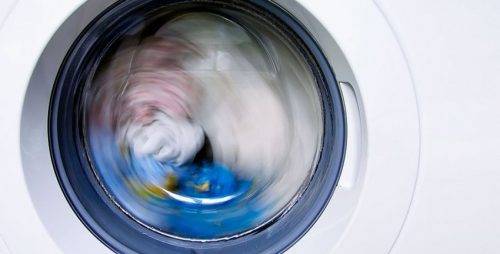
If the quality of washing must be high all the time, then there is no such need for a very strong spin. Yes, with the best performance, your jeans will come out barely wet, but intense squeezing can tear, jam the material too much.
Tip: for each material, choose a strictly suitable washing and spinning program, and then the clothes will delight you for a very long time with their bright colors and correct shape.

What are the criteria for determining the best household appliances
If you look at the ratings of automatic washing machines, you will notice that they differ from each other. This is because users and experts in their assessments give preference to one or more of the features that are most important to them. AFM is evaluated according to the following criteria:
- design features;
- reliability and durability;
- noise level and quality of washing;
- dimensions and maximum weight of loaded laundry;
- washing and spinning class;
- energy class;
- price category.
It is rather difficult to determine which washing machine is better based on the combination of the above indicators.
If we take into account the design features and the price factor, then automatic front-loading units are most common among users. Top loaders are less popular with housewives
AFMs differ from each other in size. A small family living in a small apartment will prefer a narrow unit that can hold up to 4 kg of laundry. Medium-depth machines are capable of washing 5 to 7 kg of items at a time. The full-size models can wash even more - up to 13 kg.
Budget models from well-known manufacturers are of great interest to buyers. Among them, one can single out the best washing machines, which are not inferior in quality indicators to more expensive rivals.
Washing machine spin efficiency: which class is better
So, each index corresponds to a letter, and shows how dry your laundry will become after spinning. Let's decipher this classification:
- class "G" means that the item will become dry by a maximum of 10%, and by pulling it out of the drum, it is necessary to prepare for the fact that water will flow from it in a stream;
- "F" - marking speaks of wash, wet by 81-90%, in simple terms - very wet;
- "E" - corresponds to values from 72% to 81%, which means that the clothes will still drip intensively;
- the "D" index already shows 28-37% dryness, not yet ideal, but you can take out your sweatshirt without fear of causing a flood;
- "C" - spinning is much more efficient in machines of this level: 54% -63%;
- washing machines marked "B" give us more than half dry laundry. They are bought more often than others;
- "A" will provide a minimum level of residual moisture no more than 45%, this is the highest modern indicator.

If you want to dry washed things quickly, then it would be appropriate to choose an automatic machine from the first three classes. However, there is no need to chase the highest index. In practice, laundry with practically the same humidity comes out of machines marked "A" and "B", which means that the difference in drying will be some hour. At the same time, the quality of the wash will remain equally high.
Additional functions
Often, equipment sellers try to attract a buyer by listing additional functions of the machine. But what are they and what are they for?
"Quick wash" is the best solution for those who urgently need clean laundry. The cycle in this case lasts from 15 to 30 minutes.
"Delay start" - the function helps the owner of the machine to save energy. For example, washing starts at night and consumes energy at reduced rates. Or, the owner of the equipment simply needs dry linen by a certain moment. You can delay washing from 1 to 24 hours.
“Pre-wash” removes even stubborn stains. This function soaks the laundry and then starts the main cycle.
"Bio-wash" is a kind of stain removal stage. Before washing, the machine keeps the temperature in the region of 30-40 degrees Celsius so that special granules - enzymes contained in the powder - corrode the dirt.
The function "Protection against leaks" or "AquaStop" (AquaStop) protects the machine from water leakage after washing. Can be applied using: thickened inlet hose, solenoid valve, sump. It can be complete and partial.
Unplugging the washing machine?
Oh yes no
Energy class
Energy consumption is the most significant parameter. It indicates the efficiency of the unit. With frequent operation of the device, you want to reduce the cost of electricity consumption. And the high energy efficiency class guarantees energy saving.
During the tests, the washing machine was loaded with 1 kg cotton linen. At a standard temperature of about 60 degrees, the laundry is washed within an hour. At the end of the wash, the electricity that was consumed in the process is calculated.
As a rule, the energy efficiency class is indicated by the letter A with the sign "". The current technology has a high consumption class (A, A) and saves up to 30% energy.
- "A" (newest generation) - electricity consumption - 0.17 kW / h.
- Class "A" shows that the machine will consume from 0.17 to 0.19 kWh.
- In the case of "B", the power consumption will be in the range from 0.19 to 0.23 kW / h.
- Consumption of class "C" will be from 0.23 to 0.27 kW / h.
- A machine marked "D" will consume between 0.27 and 0.31 kWh.
- Equipment marked "E" will consume from 0.31 to 0.35 kW / h.
- Class F washing machine - from 0.35 to 0.39 kW / h.
- The most expensive will be "G" - from 0.39 kW / h.
Competition in the machine market today is great and the manufacturer is fighting for the buyer, constantly modernizing them. The usual classification of machines from seven grades ("A" - "G") has long included equipment with the "A" sign. But the leaders in the production of washing machines do not stop there - in retail chains you can more and more often find models of a higher class.
Types by size and loading
By the type of loading, the machines are divided into frontal and vertical. Frontal ones can most often be found in retail chains - this is a familiar technique with a transparent round-shaped door, reminiscent of a porthole. In a top-loading machine, laundry is placed through a special opening at the top.
There is no significant difference in these two models, except for the location of the bearings and dimensions. Here everyone finds for himself what is closer to him.
The size is chosen, usually focusing on the area of the bathroom and the need for washing:
- The machine, 32-35 cm wide and with a load of 3 to 4 kg, fits perfectly even in a small room and is suitable for a family of two. Unfortunately, the down jacket or blanket cannot be washed in it.
- Larger equipment with a capacity of 5 to 6 kg and a width of 40-45 cm can easily cope with washing a large item. Accordingly, it is suitable for serving a family of 3-4 people.
Do you machine wash your shoes?
Oh yes no
Specifications
7 groups were identified that determine the quality of washing, energy efficiency and energy consumption of washing machines. The better the washing results, the higher the class is assigned to the household appliance. Let's take a look at these classes and define their specific parameters and values.
A
Class A is characterized by the best result, effective and high-quality removal of all types of contamination. The washing quality coefficient is 1.3 and higher, the energy consumption is 0.17-0.19 kWh / kg. And also class A is characterized by the maximum drum rotation speed, spin rates, energy efficiency less than 45%.
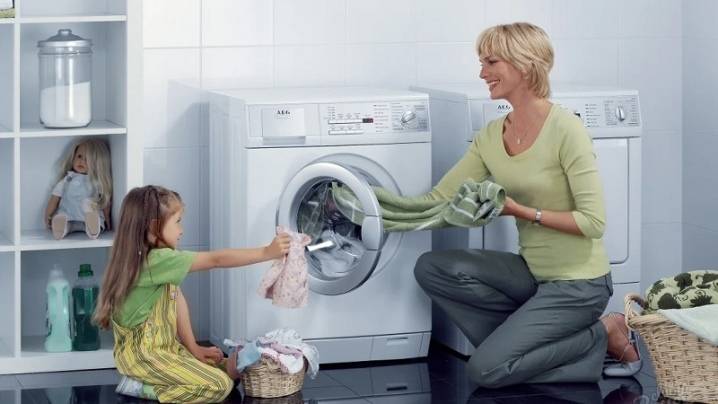
B
Washing machines labeled with this Latin letter are also pretty good. Class B is characterized by the following parameters: quality factor 1-1.3, power consumption 0.19-0.23 kWh / kg, spin factor 45-54%.

C
Has the following parameters:
- washing quality coefficient 0.97-1;
- electricity consumption 0.23-0.27 kWh / kg;
- spin ratio 54-63%.
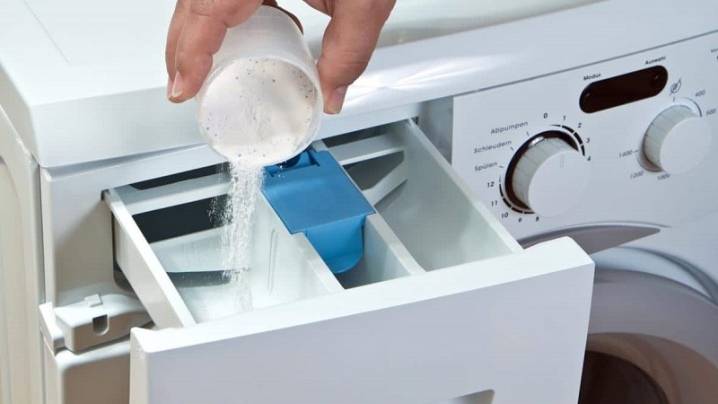
D
These washing machines are characterized by:
- washing quality coefficient 0.94-0.87;
- electricity consumption 0.27-0.31 kWh / kg;
- spin ratio 63-72%.
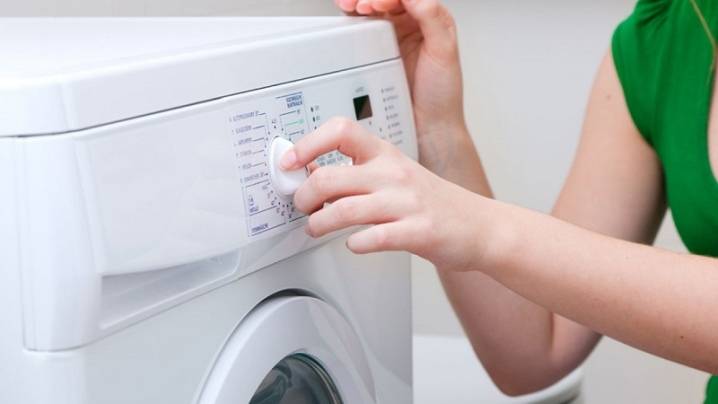
E
A washing machine of this class is characterized by the following parameters:
- washing quality coefficient 0.91-0.94;
- electricity consumption 0.31-0.35 kWh / kg;
- spin ratio 72-81%.
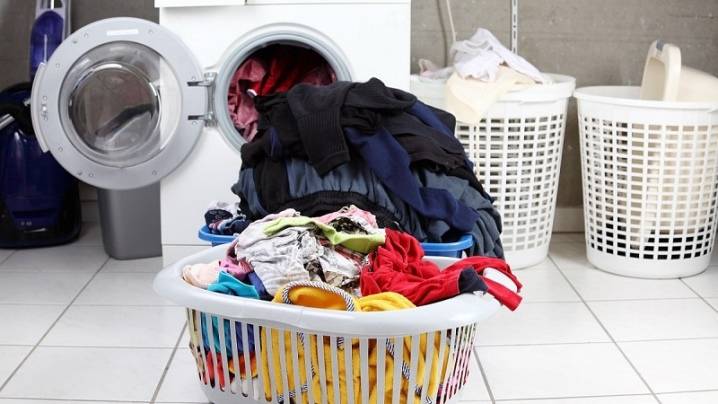
F
This class is characterized by:
- washing quality coefficient 0.88-0.91;
- electricity consumption 0.35-0.39 kWh / kg;
- spin ratio 81-90%.
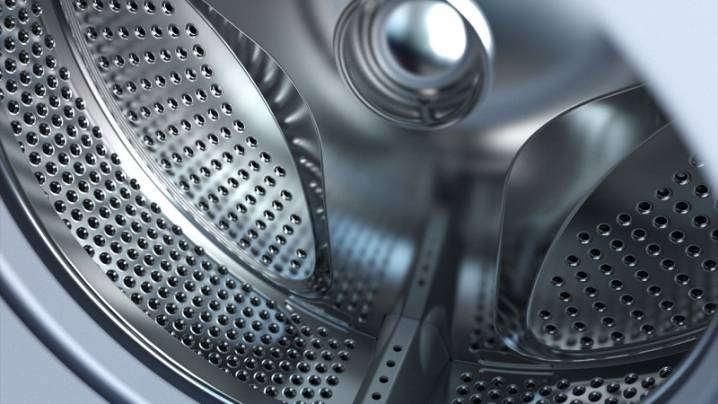
G
Such a household appliance has the following parameters:
- washing quality factor 0.75-0.88;
- power consumption> 0.39 kWh / kg;
- spin ratio> 90%.

As you can see, the last 3 classes have the lowest technical parameters.These washing machines do not wash very well, they practically do not wash the dirt, they consume a lot of electricity and after using the "Spin" mode, things remain wet.
It is important to know and understand the following: a branded class A washing machine can cost significantly more than a unit of a little-known brand. But this parameter of the machine is determined by one method, and the devices will wash the same
Therefore, whether or not to overpay for a big brand name is up to the consumer to decide. From the above information, we can also conclude that the better the washing machine wring out things, its drum makes a large number of revolutions, the more electrical energy it consumes.
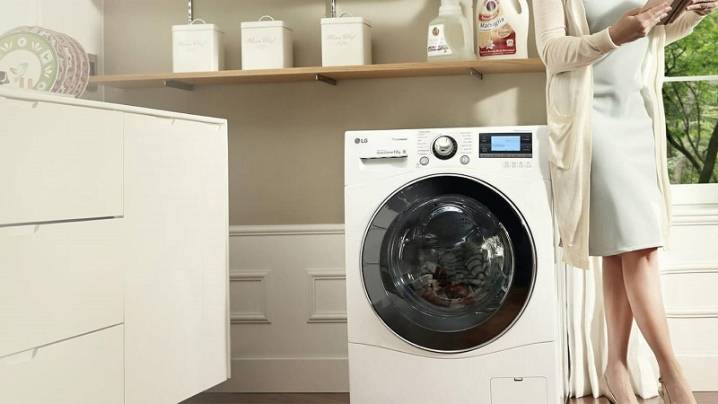
Tips for future owners
When choosing a washing machine, it is recommended to take into account not only the spin class, but also other main characteristics: water consumption, energy consumption, number of modes, manufacturer. If the main requirement is the efficiency of electricity consumption, then you should choose A ++ class household appliances. However, for those who prefer to dry their clothes in the fresh air (backyard of a private house or balcony), the spin class will not have a priority value - you can safely take a washing machine with a spin class below "B".
However, it should be remembered that not completely wrung out things in a wet state become heavier (this is especially true for terry towels, blankets and blankets). The owner of a washing machine with a low spin class will have to make extra efforts each time to get the laundry out of the drum and send it to dry. If there are prohibitions on such effects on fabrics, it is recommended to purchase a household unit that will provide the possibility of dry washing.
Share link:

